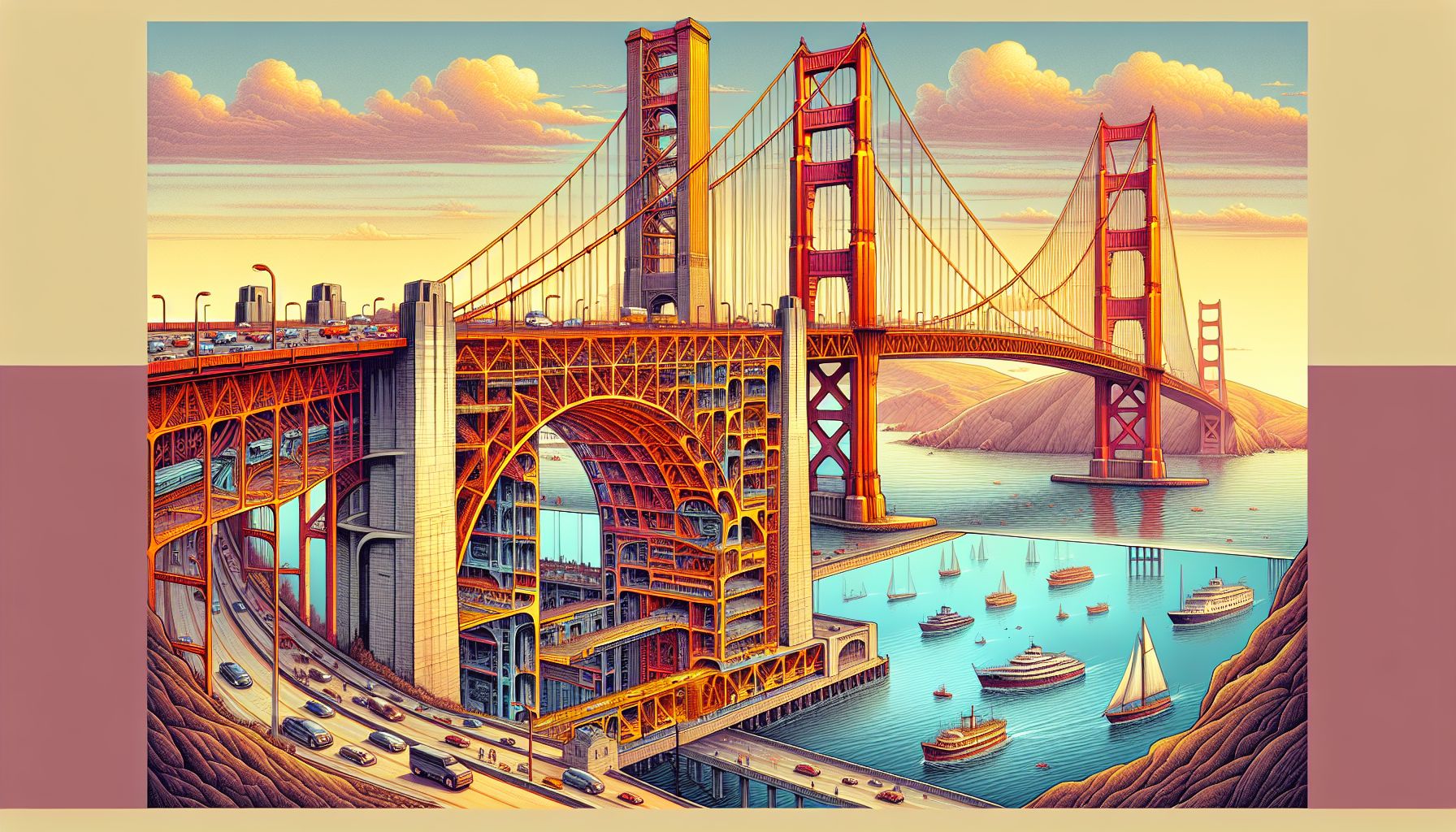📌 Let’s explore the topic in depth and see what insights we can uncover.
⚡ “Did you know that the Golden Gate Bridge, an iconic symbol of San Francisco, was once dismissed as ‘an impossible feat’? Let’s unravel the audacious engineering secrets that made this ‘impossible’ dream a concrete reality!”
At the heart of the beautiful city of San Francisco, the Golden Gate Bridge stands proud and tall, a testament to human ingenuity and determination. This iconic structure, often shrouded in a mystical fog, is more than just a picturesque tourist magnet. It’s a marvel of modern engineering, a symbol of architectural prowess, and a story of relentless ambition. Let’s embark on an intriguing journey, diving deep into the engineering marvels that make the Golden Gate Bridge an unforgettable spectacle and an enduring symbol of the city by the bay.
🎨 The Birth of an Icon: Planning and Design

"Unveiling the Golden Gate Bridge's Engineering Wonders"
In the era of horse-drawn carriages and steamships, the idea of a bridge spanning the mighty Golden Gate Strait was nothing short of a pipe dream. The visionaries of the time, however, were not to be deterred. The task of designing this architectural marvel fell upon the shoulders of Joseph Strauss, a talented engineer with a penchant for ambitious projects. He proposed an innovative design that combined elements from both suspension and cantilever bridge designs. However, the final design that we marvel at today was the product of a collaborative effort, with significant contributions from engineering giants like Leon Moisseiff and architect Irving Morrow. The final design was a suspension bridge with a main span of 4,200 feet - the longest in the world at the time of its completion. The bridge stands 746 feet above the water, with two magnificent towers supporting a massive steel cable. It’s hard to imagine, but this colossal structure was designed and planned with nothing more than pencils, paper, and slide rules!
🛠 The Build: Overcoming Challenges
Building the Golden Gate Bridge was no easy feat. Engineers and workers faced a multitude of challenges, from the strong ocean currents and relentless winds to the treacherous depths of the Golden Gate Strait. The construction process began with the towers. Two gigantic steel towers, each weighing 44,000 tons, were erected on the two sides of the strait. The foundations for these towers were laid deep into the ocean bed, with the workers working inside pressurized caissons to keep the water out. Next came the anchorage and the cables. The two main cables, each over a mile long and weighing 24,500 tons, were spun from 80,000 miles of steel wire - enough to encircle the Earth three times! These cables were then anchored on both ends to massive concrete blocks, which hold the bridge’s weight and resist the forces of wind and traffic. The last step was the roadway. The roadway, suspended from the main cables via vertical suspender cables, was built in sections and hoisted into place. This was a particularly tricky process, as the workers had to battle high winds and precarious heights. Despite the challenges, the Golden Gate Bridge was completed in four years and under budget - a true testament to human resilience and determination.
🎈 Floating on Air: The Aerodynamics of the Golden Gate Bridge
One of the most intriguing aspects of the Golden Gate Bridge is its aerodynamics. The bridge’s location, exposed to strong winds from the Pacific Ocean, demanded careful consideration of wind forces in its design. The bridge is designed to flex and bend with the wind, a feature that prevents it from snapping under stress. The deck is also slightly curved, allowing the wind to flow over it smoothly and reducing wind resistance. Another interesting feature is the use of ‘vortex shedding’. When the wind blows against the bridge, it creates small whirlwinds or ‘vortices’ that can cause the bridge to vibrate. To combat this, the bridge was designed with a streamlined cross-section that disrupts these vortices, minimizing vibrations.
🎯 Standing the Test of Time: Maintenance and Upgrades
The Golden Gate Bridge is not just a marvel of engineering, but also of maintenance and upkeep. Since its completion in 1937, the bridge has undergone several upgrades to keep it safe and operational. One of the major upgrades was the installation of a movable median barrier in 2015 to prevent head-on collisions. The bridge also underwent a seismic retrofit in the late 1990s to make it more resistant to earthquakes. Perhaps the most well-known aspect of the bridge’s maintenance is its endless painting. The bridge is constantly being painted to protect it from corrosion, with painters starting at one end and working their way to the other, only to start all over again.
🧭 Conclusion
From its inception to its continued maintenance, the Golden Gate 🧠 Think of Bridge as a marvel of engineering, a testament to human ingenuity and determination. It’s more than just a bridge - it’s a symbol of ambition, resilience, and the relentless pursuit of progress. As we marvel at this iconic structure, let’s remember the numerous engineers, architects, and workers who made this dream a reality. Their innovation, courage, and hard work continue to inspire us, reminding us of what we can achieve when we dare to dream big. So, the next time you find yourself gazing at the Golden Gate Bridge, whether in person or in a photograph, take a moment to appreciate not just its beauty, but also the engineering marvels that make it stand tall.
🌐 Thanks for reading — more tech trends coming soon!
